Zebra Danios are one of the easiest types of freshwater fish to find tankmates for. They’re like that one roommate who picks up after themselves and gets along well with almost everyone.
Of course, not every fish makes a good companion. You should select varieties that have similar needs in terms of water temperature, pH, and other environmental considerations. It’s also important to choose Zebra Danio tankmates with compatible temperaments.
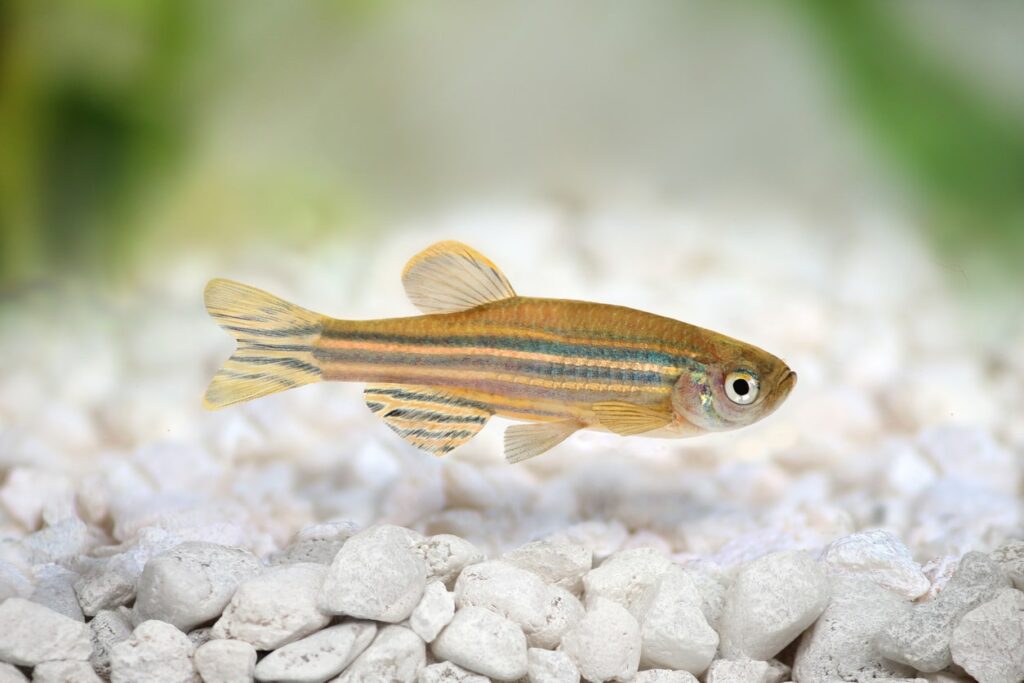
Before we get into that, let’s go over some Zebra Danio care basics.
Caring for Zebra Danios
- Common Names: Zebra Fish, Zebra Danio
- Scientific Name: Danio rerio
- Size: Up to 2 inches
- Lifespan: 5 years
- Water Temperature: 64-75 degrees Fahrenheit
The Zebra danio (aka Zebrafish) is a really sensible choice for a community tank. Their signature striping adds a bit of whimsy to your aquarium. Plus, they’re incredibly easy to take care of.
Zebra danios are versatile and robust, and they can thrive within a rather wide range of temperatures. While they mostly inhabit the upper portions of an aquarium, don’t be surprised to see Zebra danios exploring all over the entire tank. Be sure to include some plants in a Zebra danio aquarium, as this will more closely resemble their natural surroundings.
These small fish are very lively and are not shy fish. Zebra Danios are a schooling fish, meaning you should buy a minimum of 5 at a time. While they are schooling fish, your Zebra Danios may exhibit some posturing as they establish their social hierarchy. Generally, though, they won’t resort to fighting with each other over it.
Zebra danios like to eat lots of things, so keep them happy with a variety of foods. Supplement flake and pellet food with live and frozen treats when feeding Zebra Danios.
The 12 Best Tank Mates for Zebra Danios
Since Zebra danios are so friendly, they’re compatible with a number of other freshwater pets. The following fish don’t just have personalities that are aligned with that of the Zebra danios. They also require similar environmental conditions.
1. Ember Tetras
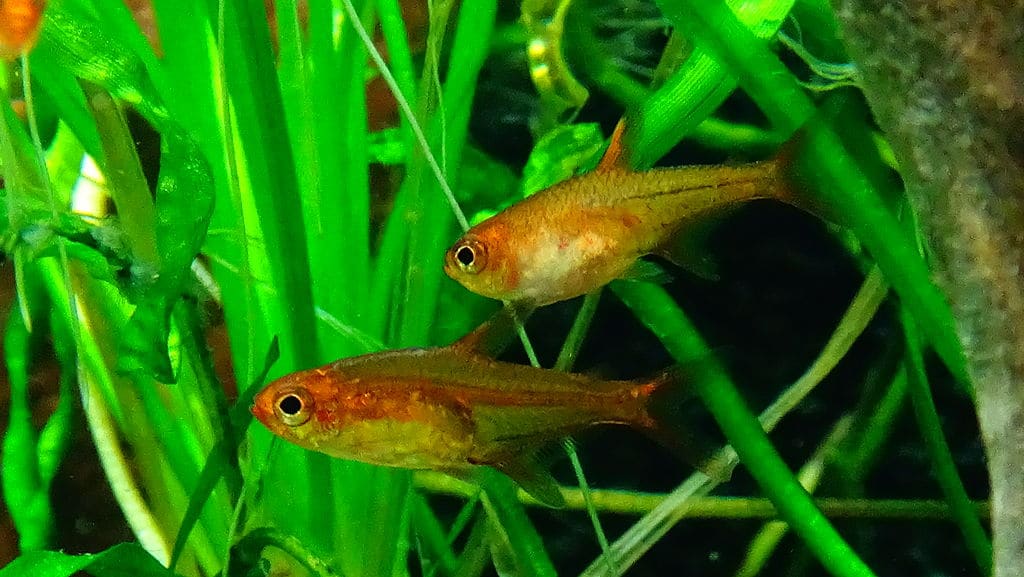
- Lifespan: 2 years
- Size: Under 1 inch
- Temperature: 73-84 degrees Fahrenheit
The Ember tetra, with its brilliant orange and red coloring, is also sold as a Fire tetra. This vibrant fish has a non-aggressive personality, and it won’t cause trouble with other aquarium inhabitants. Don’t take its peaceful demeanor to mean the Ember tetra is boring, though. These little fish are full of life, and you’ll often see them gleefully flitting about the tank (much like Zebra danios).
Ember tetras love a lot of greenery to explore and use as hiding spots. They like to travel in groups and will exhibit spirited behaviors once they’re comfortable in a new home. Watch for these little characters to play hide and seek with their friends, among other adorable antics.
Embers are omnivorous and enjoy eating veggies and animal protein. Try to provide a diverse diet to keep your fiery little tetras healthy.
2. Platies
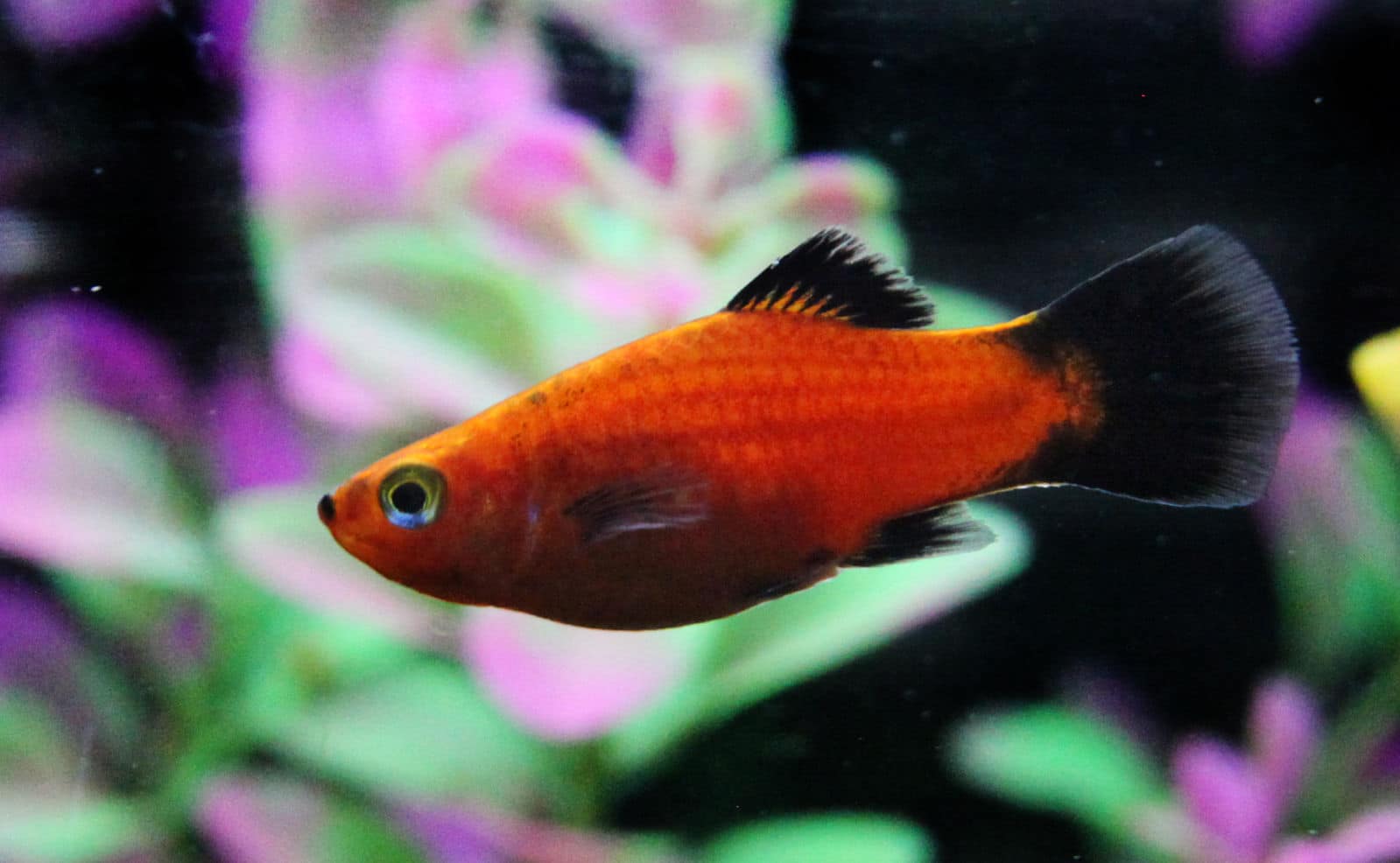
- Lifespan: About 3 years
- Size: 2 ½ – 3 inches
- Temperature: 68-82 degrees Fahrenheit
Platies are small, peaceful, and come in a dazzling variety of colors such as red, green, blue, and yellow. They’re relatively simple to take care of and are often recommended to first-time aquarium hobbyists.
Platy fish are livebearers like guppies, mollies, and swordtails. So assuming you keep them happy they will fill your tank with baby fish in no time at all. Here are a few of the most common color varieties you will find at your local pet store:
- Red Coral: This type of platy will add some vibrancy to your tank with its vivid red color.
- Comet: The Comet variation can be seen in combination with other patterns and color morphs. The term denotes platys that have distinctive black trim on the top and bottom edges of their tailfin.
- Bleeding-Heart: Bleeding Hearts have rosy streaks that run vertically down their bodies.
- Sunset: Sunset platys, like their namesake, are really quite lovely to behold with glowing yellow and orange bodies.
- Salt and Pepper: S&P platys have a smattering of black and/or white spots on their bodies.
Platies tend to be happier when they have some friends, so add at least a handful of platys to your tank at once. Platys are fantastic jumpers who can leap right out of the aquarium. Make sure you have a secure lid for your tank.
As omnivores Platies eat both plant and animal matter, just like Zebra Danios. Green algae, insect larvae, baby brine shrimp, and other food are what they prefer in nature. So supplement any prepared food with frozen and vegetable-based flakes for variety.
3. Swordtails
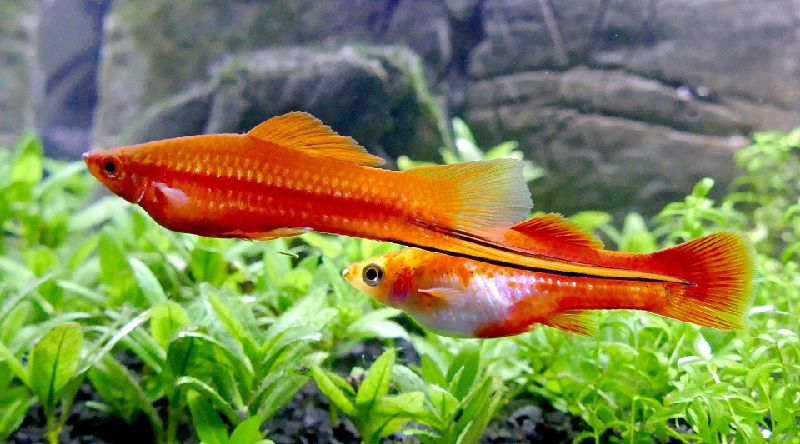
- Lifespan: 3-5 years
- Size: Up to 6 inches
- Temperature: 72-79 degrees Fahrenheit
Swordtails come in lots of color varieties, so you’ll likely see titles relating to this when you’re buying them. A Swordtail’s most distinguishing trait is its unusual tailfin, the bottom of which is elongated and looks rather like a sword extending from behind the fish.
Like Zebra Danios, Swordtails are very adaptable when it comes to their tank environment. These active and lively fish like to run in groups. Keep them at about a 3 or 4:1 female-to-male ratio.
Swordtails are also jumpers, so keep that lid on tight whenever you’re not feeding your fish or cleaning your tank.
In the wild, Swordtails consume a lot of algae and plant matter and are as omnivorous as Zebra Danios. They also fancy a bit of animal protein from time to time. Supplement their mostly plant-based diet with other foods like brine shrimp.
4. Kuhli Loach
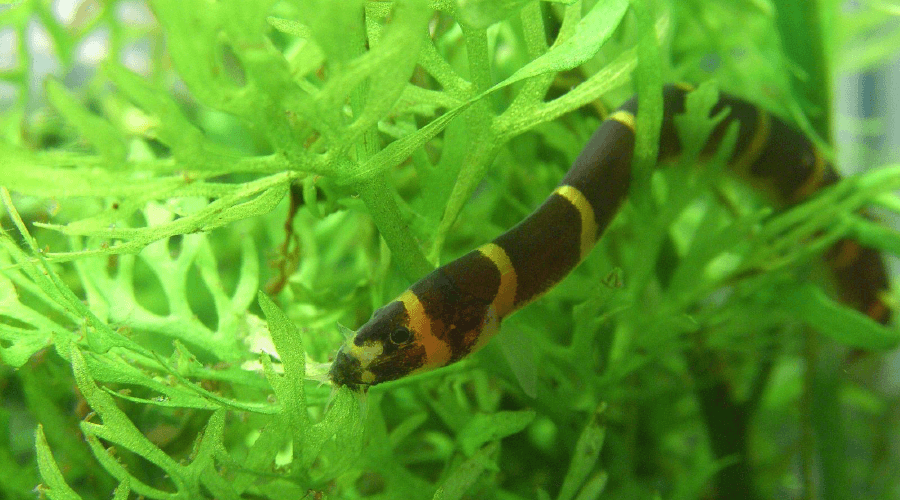
- Lifespan: Up to 10 Years
- Size: About 4 inches
- Temperature: 75-86 degrees Fahrenheit
Kuhli Loaches are nocturnal scavenging fish that have elongated bodies and look somewhat like small eels. As if their shape wasn’t interesting enough, they have bold stripes running across their bodies and 4 pairs of barbels protruding from their mouths. It is best to keep Kuhli Loaches on a small-grained gravel or sand substrate. These fish love to burrow but large gravel grains can scratch their soft skin.
Kuhli loaches will hide out and rest during the day, then come out at night to look for bits of food at the bottom of the tank. You may want to purchase a nighttime viewing light, which will enable you to observe your nocturnal tank dwellers without disturbing their day/night cycle.
Kuhli loaches are mostly carnivorous but it’s good to give them some vegetable-based foods for balance. Worms, brine shrimp, and insect larvae are their absolute favorite foods, though. Two items your Zebra Danios eat as well.
5. Corydoras Catfish
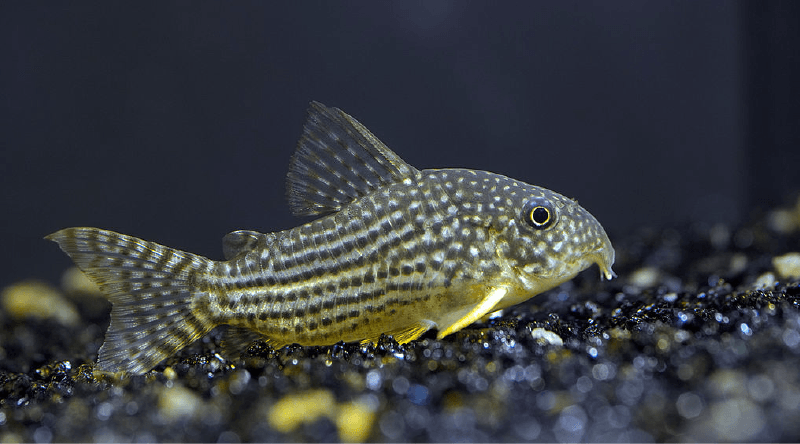
- Lifespan: Approximately 10 years
- Size: 1-3 inches
- Temperature: 70-80 degrees Fahrenheit
One of the best tank mates for Zebra Danios is the Cory Cat. Short for Corydoras Catfish, these small fish have a peaceful nature and are very social fish species. Zebra Danios will fill the upper region of your tank with activity while your Corydoras school along the bottom. This makes them a great combination for a community tank. Cory Cats are well known for their synchronized swimming routines and other entertaining antics.
While Cory Cats can withstand a fairly wide range of water conditions, it’s imperative to stay consistent once you’ve established your tank’s parameters. They even help keep the tank clean by finding uneaten food along the bottom.
You have a choice when it comes to Cory Cats. Various types (some different species, others simply “morphs” achieved through selective breeding) are available on the aquatic pet market. Here are a few of the most popular types of Cory Cats.
- Julii: True Juliis are somewhat rare, but False Juliis abound – and most of us really can’t tell the difference. Everyone loves the intricate maze-like patterns on their bodies.
- Peppered: Peppered Corys have dark speckles on their bodies, hence the name. The base color of a Peppered cory can vary (usually a range of shimmery greens and browns), as can the arrangement of their spots.
- Pygmy: As you might have gathered, the Pygmy Cory is very small. Aside from its size, another thing sets the Pygmi apart from its fellow Corys. This tiny catfish doesn’t just hang around the bottom of the tank, and instead swims in the open waters higher up.
- Sterbai: Sterbais are lively and easy to take care of. They’re also very cool-looking, with elaborate black patterning that almost appears to shift as you look at it.
- Albino: Albino Corys are, of course, white. They also have the signature pink eyes of albino animals.
- Panda: Pandas have white bodies and dark panda-esque markings on their heads and tails.
6. Cardinal Tetra
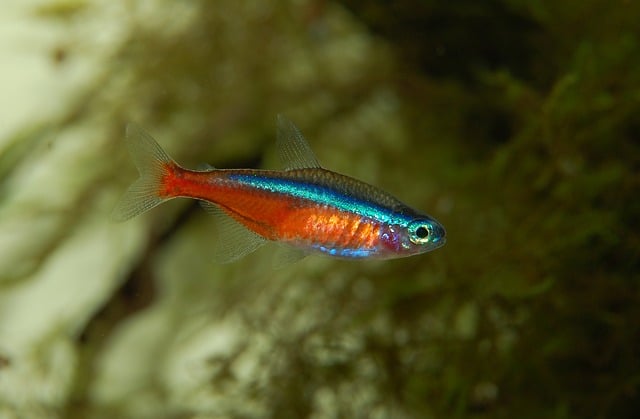
- Lifespan: About 4 years
- Size: Around 2 inches
- Temperature: 73-81 degrees Fahrenheit
You may hear the Cardinal tetra referred to as a Red Neon tetra. In any case, this little fish is a hit among hobbyists and it is closely related to the true Neon Tetra. They have a fiery red underside, capped off by a shimmering strip of icy blue-green, quite different from the Zebra Danio.
As colorful and active shoaling fish as they are, Cardinal Tetras are great tank mates for Zebra Danio fish. They love each other’s company so make sure there are several other Cardinals in the tank for them to hang out with. When kept alone they tend to become severely stressed, similar to a lone Zebra Danio.
Cardinal tetras are carnivorous and enjoy protein-rich live or frozen food along with prepared flakes and pellets. Just be sure to give them a good variety to make sure they’re getting proper nutrition.
7. Small Barbs
- Lifespan: Up to 5 years, depending on species and care
- Size: 6 inches or under
- Temperature: 75-80 degrees Fahrenheit
Barbs are some of the most popular freshwater fish and most will make great tank mates for your Zebra danios. Be aware that some, such as the Tinfoil barb, can grow to be over a foot long. The following barb varieties are suitable for cohabitation with Zebra danios.
Gold Barb: This barb has become quite popular with hobbyists. Gold barbs are actually more greenish when found in the wild. Through selective breeding, most sold in pet shops display the more recognizable golden hue. Gold barbs are versatile, exuberant swimmers. Give them some fellow Goldies to school with; they’ll do much better in groups of 6 or so.
Zebra Barb: If you want to keep your zebra theme going, Zebra barbs are there with all the black and white stripes you can handle. Zebra barbs are peaceful, but they are not mellow. They’re very energetic and need plenty of room to swim. Note that Zebra barbs are sometimes sold as Striped barbs. They also like to gather with other Zebras.
Black Ruby Barb: The Ruby barb gets its name from the way it displays a flush of deep red at maturity. Rubies can add some rich color to your aquatic landscape. What’s more, they’re fun to keep. Easygoing, yet active, these little barbs are curious explorers who will happily swim most of the day. Like other barbs, they enjoy the company of a few same-species friends.
8. Guppies
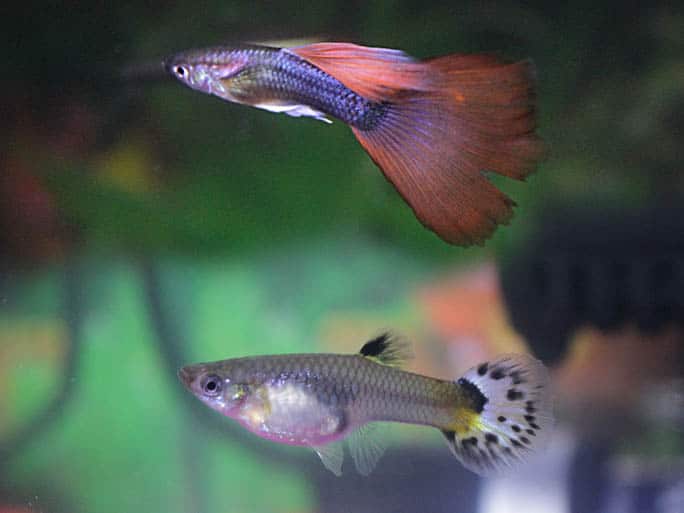
- Size: ½ inch – 2 ½ inches
- Lifespan: 2 years
- Temperature: 74-82 degrees Fahrenheit
One thing about guppies is that there are many varieties of them. In fact, there are more than 300 different types to choose from. Many color and pattern combinations are available, as well as a few with unique fin shapes. Another thing about guppies is that they are visually stunning, regardless of type. Look at a tankful of guppies and you can’t really help but be delighted by the vivid colors and striking patterns.
Though “guppy” is the most common name, these fish are sometimes called Rainbowfish (because of all the colors, of course) and the Million fish (because they are so prolific). Guppies do best in groups just like Zebra Danio fish. They’re sociable and enthusiastic, spending their days swimming all over the place.
Guppies are some of the most popular freshwater fish and come in several beautiful varieties:
Tuxedo: These distinguished little guppies have half-black, half-white bodies. This makes them look quite a bit like they’re wearing a tiny tuxedo. Most have a bit of added flair in the form of a colorful tailfin.
Snakeskin: Snakeskin guppies have distinctive patterns, usually consisting of braided or chainlike bands. Sometimes called Cobra guppies, they may also display separate rosette-like spots. They come in various colors and color combinations.
Metal: Metal guppies are so-called because of their shimmering, metallic coloration. The fins of Metal guppies are actually iridescent, which means they reflect the colors around them – seeming to change color (very pretty to watch them swim)
Lace: This term refers to guppies with lace-like patterns on their tailfin. It’s commonly found on Snakeskin guppies, but it’s totally possible to see it with other variations.
Albino: True Albino guppies lack melanin, which makes their bodies devoid of color. Look for the signature pink eyes to determine whether a guppy is indeed an Albino.
9. Clown Pleco
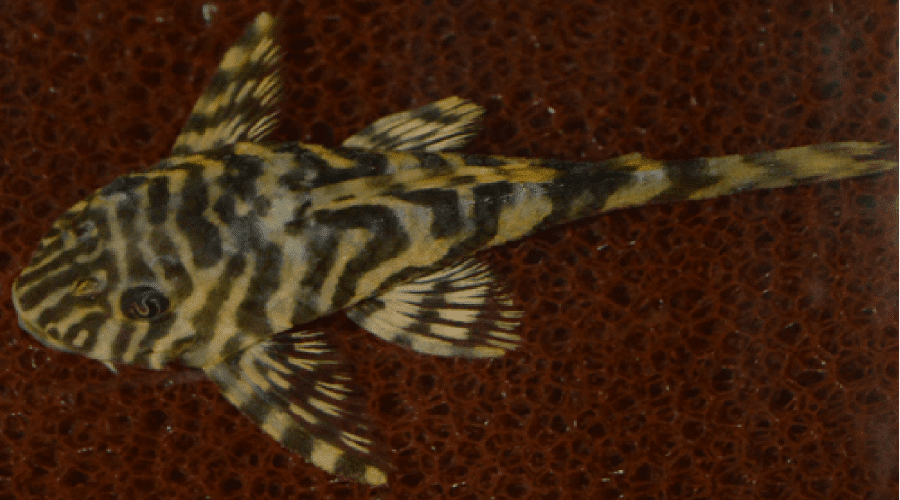
- Size: 3-4 inches
- Lifespan: up to 10 years, sometimes longer
- Temperature: 73-82 degrees Fahrenheit
Small plecos (short for Plecostomus) such as the Clown pleco are ideal tankmates for Zebra danios. Not only are they peaceful, they’ll mind their own business hanging around on the bottom of the tank.
While coloring can vary quite a bit among Clown plecos, they are most commonly seen with dark black and white or orange banding. Clowns are generally mild-mannered, but a male pleco may get aggressive with another male. It’s not advisable to place two male plecos in the same aquarium.
Plecos are algae-eaters, but Clowns aren’t as big on the many types of green algae as most other types. Clown plecos prefer to dine on wood, so it’s very important to add driftwood to their habitat. It’s unlikely they’ll get all the nutrients they need from driftwood and tank debris, though. You should also toss some animal protein in the tank just for your Clown pleco every so often.
10. Harlequin Rasbora
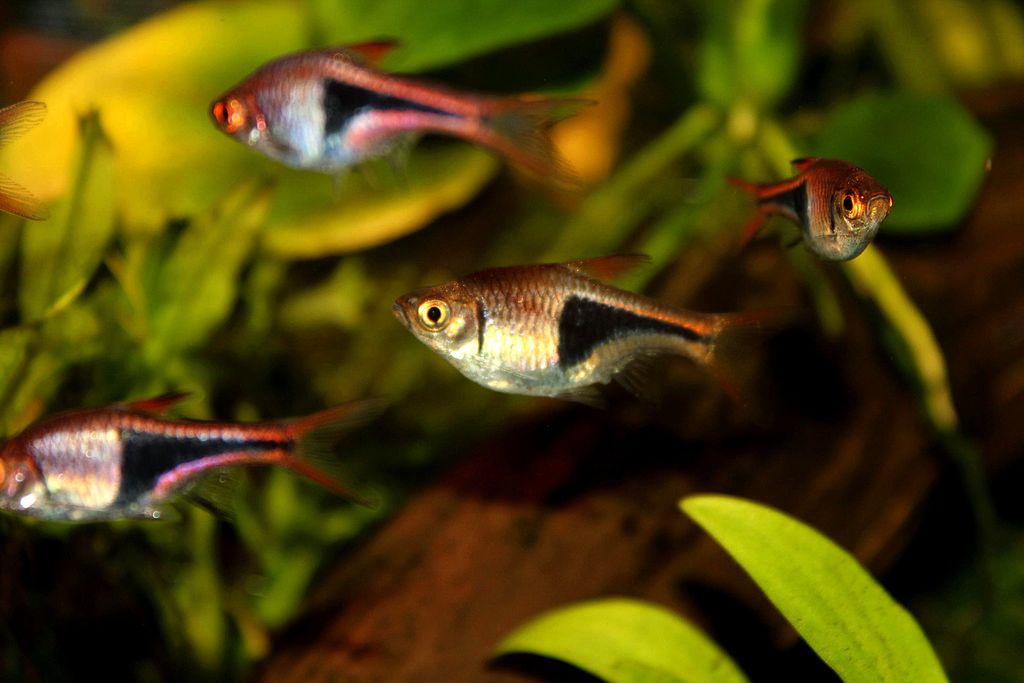
- Lifespan: Around 5 years
- Size: 1-4 inches
- Temperature: 75-81 degrees Fahrenheit
Harlequin Rasboras are a great fit for community tanks with other non-aggressive fish. Harlequins are very attractive, with a lovely configuration of silver with orange accents – and a signature black section near the tail.
Rasboras like a heavily planted tank with plenty of places to hide. They thrive when allowed to school, and it’s recommended to get several at once. As with most schooling fish, it’s advisable to keep more females than males. The substrate isn’t a major concern, since these fish probably won’t hang out near the bottom of the aquarium.
Harlequin rasboras and Zebra Danios eat micro pellets, flake food, and anything else you feed them. They’ll also eat plankton, worms, small crustaceans, and insects. So rotate these things into their feeding schedule sometimes.
11. Honey Gourami
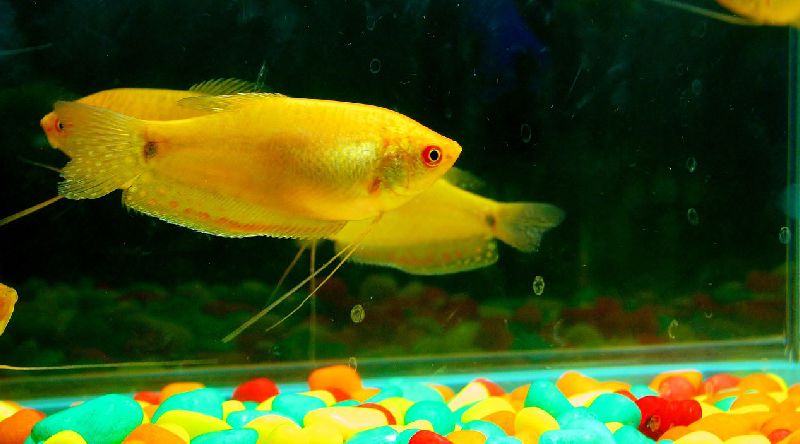
- Size: up to 3 inches
- Lifespan: up to 8 years
- Temperature: 74-82 degrees Fahrenheit
Honey Gourami get their name from the honey-colored scales commonly displayed in males (the females are usually gray or silver). Both sexes of Honey gourami are born with this duller coloration, with males developing changes upon maturity.
Honey Gourami are shy and friendly, making them great community tank mates for the Zebra Danio. They like to inhabit the middle and upper portions of the tank, so they won’t care much about what kind of substrate you use at the bottom. These fish are hardy and relatively easy to keep healthy.
Honey gourami do well in schools of 4-6 fellow tropical fish. They’re not usually aggressive, although one fish in the group may exert dominance over the more docile ones. You’ll just have to keep an eye on this.
These fish are usually pretty happy to eat just about anything you put in the tank, and they like both veggies and meat. Just keep it balanced and diverse, and your Honey gourami will be well-nourished.
12. Ghost Shrimp
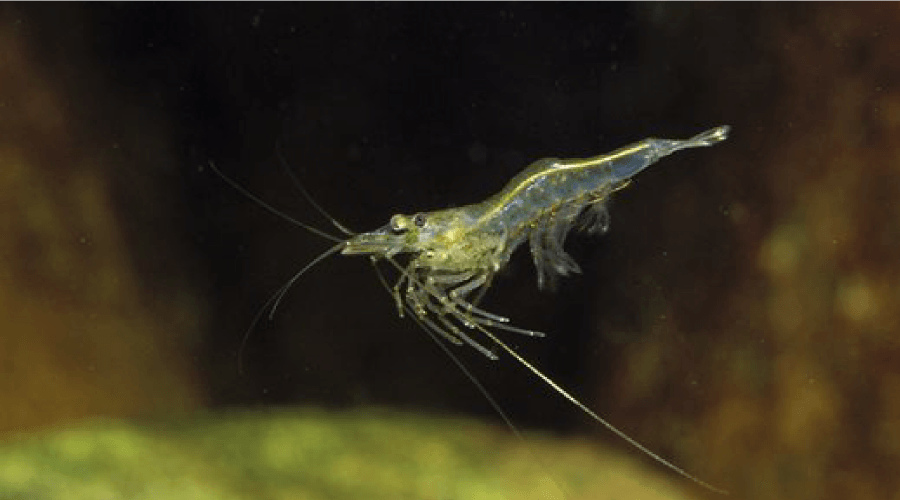
- Size: 2 inches
- Temperature: 68-85 degrees Fahrenheit
Sometimes, it’s fun to add something that’s not an actual fish to your aquatic community. Ghost shrimp usually make a suitable choice. They’re small and friendly, and they are always entertaining to watch. Just make sure any other fish you choose aren’t large enough to eat shrimp.
Ghost shrimp do not require the company of other Ghost shrimp, so it’s okay if you only have space to accommodate one of these charming crustaceans.
Ghost shrimp are more than just fun additions to your zebra danio tank. They will also help keep it clean by scavenging bits of food and other debris lurking around. They’re voracious eaters, so you may need to provide some additional snacks for them.
Other Fish that Don’t Make Good Tank Mates for Zebra Danios
Despite all their endearing qualities, there are a few other fish who don’t get along with the Zebra danios.
Long-Finned Fish
Fish with ornate, trailing fins (like Angelfish or Betta Fish) are beautiful to behold. However, they do not make good tankmates for the Zebra Daniofish. This is because some Zebras Danios will nip at their long, flamboyant fins. Adult angelfish can also grow large enough to eat Zebra Danio fry and young fish.
Shy or Tiny Fish
Even though Zebra danios are very peaceful they’re also very active fish. Shy and retiring community fish can sometimes be stressed by how hectic a school of Zebra Danios can be as they race around the tank. Tiny nano fish like Chili rasboras are poor tank mates for this reason.
Aggressive Fish
If you have a fish that’s a bit of a bully, don’t place it with the peaceful Zebra Danio. Cichlids and other aggressive fish will easily bully a group of Zebra Danios, especially if the tank size is too small.
Very Large Fish
Community fish that are significantly bigger than your Zebra Danios might just compete a bit too aggressively for space. What’s more, they are likely to eventually eat your Zebra Danios. Don’t risk it. Place your Zebra danios with fish that are at least somewhat similar in size.
Care Tips for Your Zebra Danio Community Tank
The fish on this list, including the Zebra Danio, enjoy having some greenery in their environment. This helps replicate their natural habitat, which keeps them healthier and happier.
However, it’s really important to provide plenty of open space for your Zebra Danio fish to swim freely. Maintain a balance between unobstructed water and features such as plants and wood.
Maintain consistent conditions
Fish, particularly freshwater varieties like the ones in this guide, are pretty picky about their water conditions. Even hardy fish can suffer if you aren’t able to keep a stable environment for them.
Choose a substrate that’s suitable for all the pets in the tank
Aesthetically speaking, most of the species mentioned in this guide have vibrant colors that stand out nicely against a dark-colored substrate.
A few smaller feedings per day are generally better than one big eating session. If your schedule doesn’t allow this, just be sure you aren’t under (or over) feeding them.
Be sure that everyone in your tank is getting enough
This could mean distracting one group of fish by conducting a feeding on the far side of the tank. While they’re eating, feed another group on the other side.
Take it slow when introducing new fish
Anytime you’re putting fish into a new aquarium, it’s important to get them properly acclimated first. When you buy a new type of fish, ask the breeder or seller about the conditions they’ve been kept in and what you should do to ease the transition to the environment in your tank.
Make sure your tank has been fully cycled before introducing any fish. If you’re not familiar with doing this, read up so you can make sure the water is suitable for adding fish.
Beware of overstocking
It’s easy to get caught up in selecting fun fish to put in your aquarium. Put too many fish in one space, though, and none of them will be happy.
The problem is that an overfilled aquarium doesn’t provide enough space, oxygen, filtration, or nutrients for its inhabitants.
These conditions are akin to hanging a welcome sign for aquatic diseases. Further, otherwise peaceful fish may become aggressive and territorial in these conditions. If you have more fish than your aquarium can safely accommodate, it’s time to get a second one.
Get the biggest tank possible
Speaking of overstocking, you’re far less likely to overpopulate your tank if it has lots of space. There’s a general rule of thumb that says you should have 1 gallon per 1 inch of fish.
However, the ideal ratio can vary depending on the type of fish you have. One of the most common rookie mistakes first-time aquarium hobbyists make is underestimating how big of a tank they’ll need.
Err on the side of bigger, not smaller. It’s also important to remember that you don’t usually fill an aquarium all the way to the top and that a bit of the water will be displaced by all the stuff you put in there.
How to Spot Unhealthy Fish
If you’re going to keep a community tank, it’s your job to keep tabs on all its inhabitants. Watch for signs that one or more of your fish might be injured or sick. Catching a problem early gives you a better chance of successfully treating it, and allows you to minimize the risk to your other aquarium pets.
Lethargy
Most of the fish on this list are notably exuberant and active. If you find that one is acting lifeless and tired, keep an eye on it. While fish may act shy and standoffish if they are distressed (such as when they’re first placed in a new tank), a sluggish fish is likely a sick or hurt fish.
Lack of appetite
All living things love to eat and one of the first signs of trouble is when they don’t want to. When your fish is refusing basic sustenance, there’s probably an issue at hand.
Odd behavior
If your fish is swimming in a way that seems “off,” or is otherwise acting out of character, pay attention. It could be something as simple as a fish who is ready to breed. It could also be a symptom of a serious problem.
Discoloration, rough fins
If your fish is displaying drastic changes in color or its fins look ragged and rough, there’s probably some kind of issue that needs to be addressed. Certain infections could be at fault, and it could even be the result of an injury from something inside the tank (such as a plant that’s too spiky).
Creating (and Maintaining) a Healthy Habitat
The absolute best thing you can do to prevent infected fish from catching or spreading diseases is to keep your tank impeccably maintained.
Invest in a good quality filtration system
Get the highest quality filter you can afford, and make sure it’s the ideal type for your aquarium. The most important part is choosing a filter that is powerful enough to handle the load you’ll be placing on it. Read the specifications for any filter before you purchase it.
Keep the temperature stable
Use an aquarium heater if needed, and keep a thermometer in your tank. Find out the lighting needs of your fish so you can set up any bulbs it will take to accommodate them. Putting your lighting system on a simple timer is a great way to help maintain consistency.
Monitor the pH
Keep a test kit on hand and check the water regularly. Learn how to adjust the level when needed. A too-drastic change in pH can kill your pets.
Be careful about what you introduce to your tank
While it’s great if someone offers to give you a fish, snail, or another critter from their tank, proceed with caution. A new specimen could introduce disease or unhealthy bacteria. Overpopulation is also a concern, especially with snails, some of which are capable of reproducing prolifically without a partner.
Zebra danios are beautiful and lively, and it’s a fun task to create a perfect habitat for them and for their tankmates.
In Conclusion
Zebra Danios appeal to freshwater fish keepers around the world for several good reasons. They are inexpensive, beautiful, easy to care for and get along with a large number of other fish. Zebra Danio fish are very uncomplicated and also breed quite easily. In short, these schooling fish can find a place in nearly any freshwater community tank.
More Frequently Asked Questions about Zebra Danios
Still hoping to learn more about these beautiful little freshwater fish? Then here are a few more frequently asked questions about Zebra Danio care to consider.
How Many Zebra Danios Should Be Kept Together?
You should keep no fewer than six Zebra Danios together and more is always better. A lone Zebra Danio will be severely stressed as it feels as if its school is hiding from predators constantly. These are social fish so keep your Zebra Danios in a group.
How Big Does a Zebra Danio Get?
An adult female Zebra Danio will be around 2 inches long. Males tend to be slimmer and not quite as long. But the female Zebra Danio will be significantly chunkier, even if she doesn’t have eggs. It is best to keep around one female per male so they can’t bully her too much if she isn’t ready to breed.
Are Zebra Danios Easy To Care For?
Zebra Danios are incredibly hardy and some of the easiest freshwater fish to care for and spawn. As omnivores, they will eat anything you offer them. Zebra Danios also tolerate a wide range of water temperatures and parameters as long as you stay away from the extremes.
Are Zebra Danios Friendly?
Zebra Danios are peaceful even towards smaller fish and are great dither fish when kept with non-aggressive, non-predatory medium-sized freshwater fish. They will sometimes nip the fins of freshwater fish with long, flowing fins. But other than that Zebra Danios are very gentle.


I started off with a danio as advised to get 1 first and introduce another 2 weeks later. We then had the pandemic and I couldn’t get another until recently. When put in with the other it seemed the original danio did not like it so I separated it to allow the new one sone space to swim. When I added it back their behaviours reversed and the latest one chased the other to death, it got injured and died. I then got 2 platys as advised by pets at home and the danio is being such a bully and making them hide all the time and when they decide to swim the danio attacks and chases them around the tank like crazy.
Any suggestions please!
Zebra danios are usually quite peaceful fish so attacking a Platy being compatible with a danio for a tank mate is weird.I would make sure to have a enough tank space first off and I’m thinking that maybe the reason for that is either something was wrong with the other fish or u introduced them too late so your danio got used to being alone in those two weeks.but also getting two platys against one danio it could have felt threatened because they are school fish and like to be with a few danios.you were advised kind of wrong and right at the same time also I currently have 5 danios going to get a 6th since one passed away from stress of tank cleaning happens sometimes.and they do fine together I got 6 in total at first and then lost a few from
A new tank surrounding then Introduced a few more and then accepted them right away once I got into the habit of knowing how to manage a tank everything has been fine I also have neon tetras 6 of those with the danios they get alone just fine together so I would also try a different kind of fish with them and make sure they feel secure in a school of at least 3-4 each